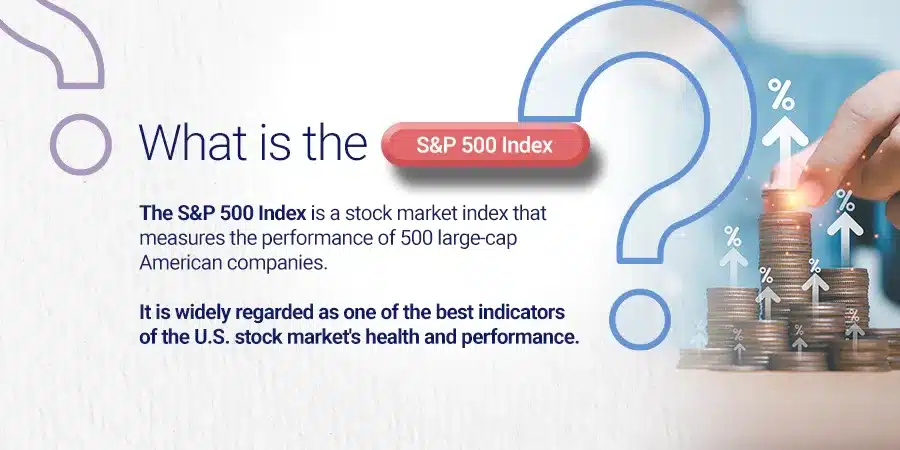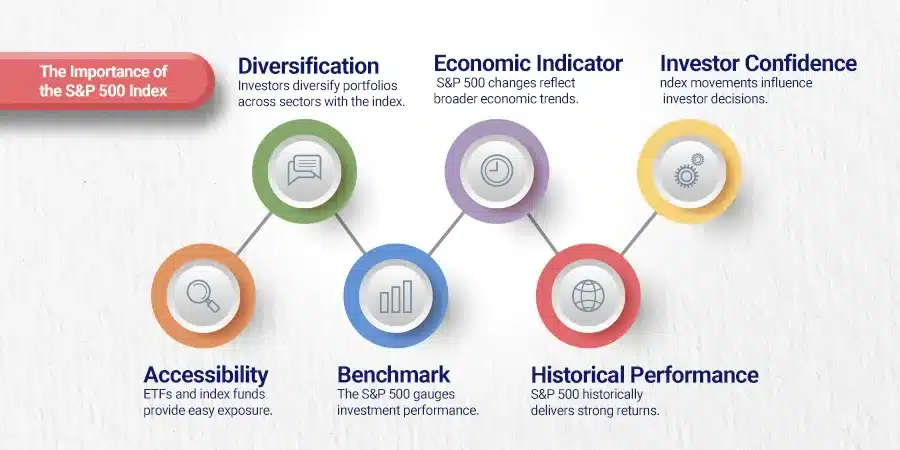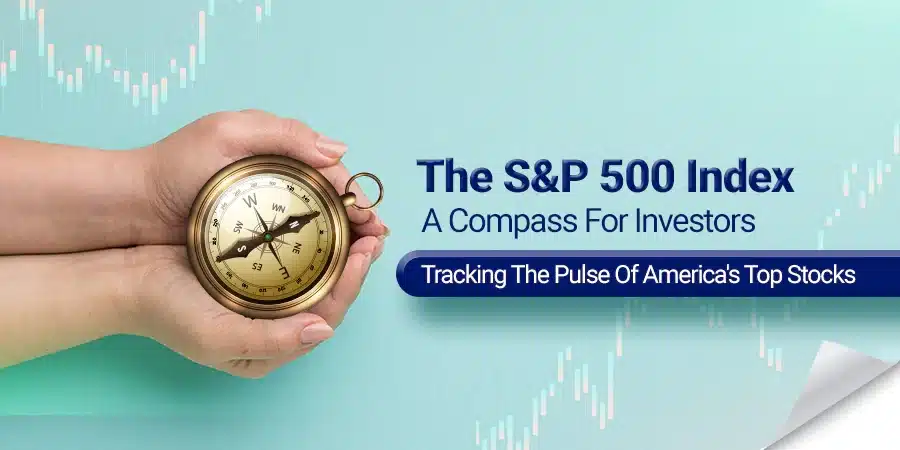Are you looking to gain a better understanding of how the stock market works? One crucial component, named the S&P 500 Index, comprises 500 leading companies and covers about 80% of available market capitalization.
This blog post will demystify the S&P 500 Index for you, explaining its importance as a key indicator of economic health and investment performance.
Ready for an intriguing journey into the world of stocks? Let’s delve in!
Key takeaways
●The S&P 500 Index fund is made up of stocks from 500 big companies traded on NASDAQ and NYSE, representing about 80% of the US stock market worth.
●The index serves as a benchmark for US equities and helps gauge the overall health of the economy. If it goes up, it means big firms are doing well and vice versa.
●Historical analysis shows consistent growth in the value of the S&P 500 Index, making it important for investors. Factors like stock news, economic data, global events, and company earnings can influence its movement.
What is the S&P 500 Index?
The S&P 500 Index is a tool. This tool counts the value of stocks from 500 companies in the U.S. These stocks are traded on two large markets, NASDAQ and NYSE. The S&P 500 includes firms like Amazon, Tesla, and Johnson & Johnson.
It shows about 80% of all U.S. stock market worth.
This index uses the price return method to set its levels.
This method looks at how much prices change over time but does not include dividends or other gains from owning a stock. So, when you hear that “the market” is up or down for the day, it often means this index has changed.

The Importance of the S&P 500 Index
The S&P 500 Index holds significant importance as it serves as a benchmark for U.S. equities and acts as an indicator of the overall economic health of the country.

A Benchmark for U.S. Equities
The S&P 500 Index works as a grade for U.S. stocks. It tells us how well or badly our stocks are doing.
For example, if the S&P 500 stocks are up by 1%, we hope our stocks also rise by that much or more.
Big firms often use this index to see if they meet their goals.
Many people look at the closing price of the S&P 500 each day. They want to know where it stands in its range over a year (3,491.58 and 4,607.07 points).
This helps them track U.S. equities’ health in real-time and make smart stock moves.
Indicator of Economic Health
The S&P 500 tells us a lot about the health of our economy. It holds shares from 500 big U.S. firms. This helps to show how these big companies are doing in the market.
If the S&P 500 goes up, it means these firms are doing well and making money. Then, we can say that the economy is strong too.
But if the S&P 500 falls down, it shows that many large firms may not be doing good business at this time so we can guess that overall economic health might be poor.
Understanding the Performance of the S&P 500 Index
Analyzing historical prices and major influential factors helps in comprehending the performance of the Index.
Analysis of Historical Prices
Historically, the S&P 500 Index has seen a consistent and considerable increase in its value. An overview of the past year’s figures is represented in the following table:
Date | S&P 500 Index Value |
52 weeks ago | 3,491.58 |
1 day ago | 4,399.77 |
52 weeks high value | 4,607.07 |
1 day range | 4,360.30 – 4,407.55 |
This overview shows a significant growth in the value of the S&P 500 Index over the past year. Within a single day, the index ranged between 4,360.30 and 4,407.55 points, indicating its volatile nature.
The highest point reached during the last 52 weeks was 4,607.07 points, showcasing the potential for high returns. The consistent upward trend of the S&P 500 Index underlines its importance for investors and its significant role in financial markets.
Major Influential Factors
The S&P 500 Index can move up or down due to important factors. Here is a list of things that have an effect on it:
- Stock news: Updates about stocks in the S&P 500 can change the index’s value.
- Economic data: Things like job reports and economic health signs can shift the S&P 500.
- Global events: Wars, elections, and big news items can make the index go up or down.
- Company earnings: If companies in the S&P 500 do well, this could push up the index.
- Interest rates: Changes to interest rates by Treasury Yields can affect stocks in the S&P 500.
- Market trends: If more people buy or sell shares, it will impact the S&P 500.
- Oil prices: Since oil has a role in many businesses, changes to its price can move the S&P 500 Index too.
The Role of the S&P 500 Index in Investment Strategy
The S&P 500 Index plays a vital role in investment strategy, offering diversification benefits and serving as a risk management tool.

Diversification Benefits
Putting money in the S&P 500 Index is a smart move. It holds stocks from many big U.S. companies.
This helps to spread risk across different areas and industries. So, if one sector has problems, others can balance it out.
For example, it includes top sectors like Information Technology and Health Care.
Lots of investors trust this method too! Assets linked to the S&P 500 add up to about $7.1 trillion! Plus, all companies in the index are from the United States, giving you a strong focus on our home market.
That’s why we say there are diversification benefits with the S&P 500 Index.
Risk Management
In risk management, the S&P 500 Index plays a big part. It helps to spread out your money. This means you don’t put all your eggs in one basket. You buy lots of different stocks instead of just one.
If one stock does badly, others might do well and balance things out. The S&P 500 Index includes top companies from many sectors. So it gives broad coverage of the U.S. stock market’s health and trends.
This makes it good for managing investment risk.
The S&P 500 Index and Market Trends
The blog post will discuss recent market movements and potential future trends related to the S&P 500 Index.
Recent Market Movements
The S&P 500 index, along with other major market indices, experienced considerable movements in the recent period. The following table outlines the major moves:
Index/ | Close | Change | 5-Day Performance | 1-Month Performance | YTD Performance | 1-Year Performance |
S&P 500 | 4,399.77 | +30.06 points (+0.69%) | -0.86% | -3.67% | +14.59% | +6.56% |
Dow Jones Industrial Average | 34,463.69 | -36.97 points (-0.11%) | N/A | N/A | N/A | N/A |
Nasdaq Composite | 13,497.59 | +206.81 points (+1.56%) | N/A | N/A | N/A | N/A |
VIX (CBOE Volatility Index) | 17.13 | -0.17 points (-0.98%) | N/A | N/A | N/A | N/A |
Gold | $1,924.80 | +$1.80 (+0.09%) | N/A | N/A | N/A | N/A |
Oil | $80.73 | +$0.01 (+0.01%) | N/A | N/A | N/A | N/A |
These figures reflect the market reactions to different economic indicators and geopolitical events, showing the interconnectedness of the global marketplace.
Potential Future Trends
In the coming months, there are several potential future trends that could impact the performance of the S&P 500 Index.
One important trend to watch is the economic recovery as countries continue to reopen from COVID-19 lockdowns.
If there are signs of strong economic growth, it could lead to increased investor confidence and potentially drive stock prices higher.
Additionally, investors will be closely monitoring any developments related to inflation and interest rates as they can have a significant impact on market volatility.
Another factor that may influence future trends is government policy changes, such as new regulations or fiscal stimulus packages.
These can create both opportunities and challenges for companies within the index.
Conclusion
In conclusion, understanding the performance and importance of the S&P 500 Index is crucial for investors and anyone interested in the U.S. stock market.
It serves as a benchmark for large-cap U.S. equities and provides valuable insights into the economic health of the country.
Analyzing its historical prices and major influential factors can help inform investment strategies while recognizing its role in diversification and risk management is essential for portfolio growth.
Monitoring recent market movements and potential future trends can further aid decision-making in this dynamic landscape.
FAQs
The S&P 500 Index is a stock market index that tracks the performance of 500 large publicly traded companies in the United States.
The S&P 500 Index is important because it provides a snapshot of how well the overall U.S. stock market is performing and serves as a benchmark for investors to assess their investment returns.
The performance of the S&P 500 Index is measured by calculating its value based on the combined market capitalization, or total value of all stocks, within its index components.
Yes, individual investors can invest in an index fund that replicates the performance of the S&P 500 Index, allowing them to indirectly participate in its performance without having to buy individual stocks from each company within it.







